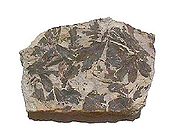Ginkgo
From Wikipedia, the free encyclopedia
| Ginkgo Fossil range: 199.6–0 Ma Jurassic[1] to recent |
||||||||||||
|---|---|---|---|---|---|---|---|---|---|---|---|---|
 |
||||||||||||
| Scientific classification | ||||||||||||
|
||||||||||||
| Species | ||||||||||||
| Synonyms | ||||||||||||
Ginkgo is a genus of highly unusual non-flowering plants with one extant species, G. biloba, which is regarded as a living fossil.
[edit] Prehistory
Fossils recognisably related to modern Ginkgo date back to the Permian, some 270 million years ago. The genus diversified and spread throughout Laurasia during the middle Jurassic and Cretaceous, but became much rarer thereafter. By the Paleocene, Ginkgo adiantoides was the only Ginkgo species extant in the Northern Hemisphere with a markedly different (but not well-documented) form persisting in the Southern Hemisphere. At the end of the Pliocene, Ginkgo fossils disappeared from the fossil record everywhere apart from a small area of central China where the modern species survived. It is in fact doubtful whether the Northern Hemisphere fossil species of Ginkgo can be reliably distinguished. Given the slow pace of evolution in the genus, there may have been only 2 in total, what is today called G. biloba (including G. adiantoides), and G. gardneri from the Paleocene of Scotland.
At least morphologically, G. gardneri and the Southern Hemisphere species are the only known post-Jurassic taxa that can be unequivocally recognized, the remainder may just as well have simply been ecotypes or subspecies. The implications would be that G. biloba had occurred over an extremely wide range, had remarkable genetic flexibility and though evolving genetically never showed much speciation. The occurrence of G. gardneri, seemingly a Caledonian mountain endemic, and the somewhat greater diversity on the Southern Hemisphere, suggests that old mountain ranges on the Northern Hemisphere could hold other, presently undiscovered, fossil Ginkgo species. Since the distribution of Ginkgo was already relictual in late prehistoric times, the chances that ancient DNA from subfossils can shed any light on this problem seem remote. While it may seem improbable that a species may exist as a contiguous entity for many millions of years, many of the Ginkgo's life-history parameters fit. These are: extreme longevity; slow reproduction rate; (in Cenozoic and later times) a wide, apparently contiguous, but steadily contracting distribution coupled with, as far as can be demonstrated from the fossil record, extreme ecological conservatism (being restricted to light soils around rivers); and a low population density.
Ginkgo has been used for classifying plants with leaves that have more than four veins per segment, while Baiera for those with less than four veins per segment. Sphenobaiera has been used to classify plants with a broadly wedge-shaped leaf that lacks a distinct leaf stem. Trichopitys is distinguished by having multiple-forked leaves with cylindrical (not flattened) thread-like ultimate divisions; it is one of the earliest fossils ascribed to the Ginkgophyta.
[edit] References
- ^ Taylor, Thomas N.; Edith L. Taylor (1993). The Biology and Evolution of Fossil Plants. Englewood Cliffs, NJ: Prentice Hall. pp. 138, 197. ISBN 0-13-651589-4.
- ^ "Genus: Ginkgo L.". Germplasm Resources Information Network (GRIN). United States Department of Agriculture, Agricultural Research Service, Beltsville Area. http://www.ars-grin.gov/cgi-bin/npgs/html/genus.pl?4960. Retrieved on 2008-03-26.


